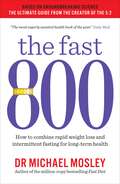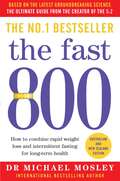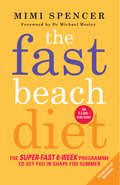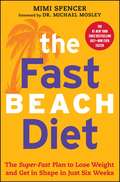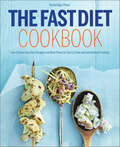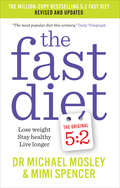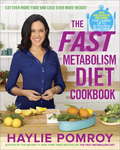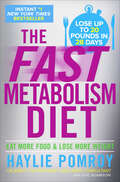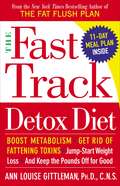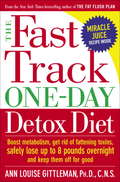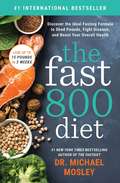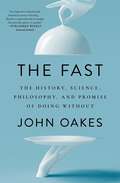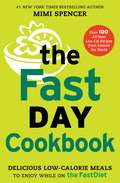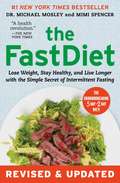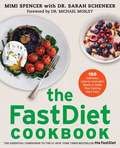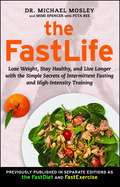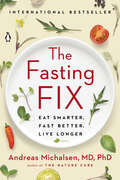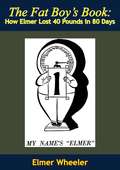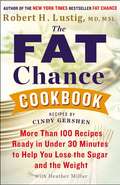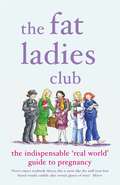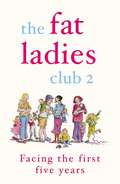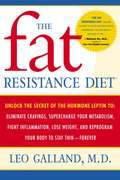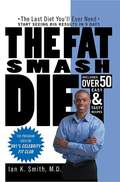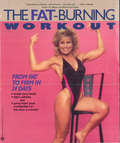- Table View
- List View
The Fast 800: How to combine rapid weight loss and intermittent fasting for long-term health (The Fast 800 Series)
by Dr Michael MosleyFROM THE CREATOR OF THE INTERNATIONAL BESTSELLING 5:2, A SIMPLE, FLEXIBLE NEW WEIGHT LOSS PROGRAMME BASED ON GROUNDBREAKING SCIENCE'The most eagerly awaited health book of the year.' Daily MailDr Michael Mosley started a health revolution with The 5.2 Fast Diet, telling the world about the incredible power of intermittent fasting. In this book he brings together all the latest science - including a new approach: Time Restricted Eating - to create an easy-to-follow programme.Recent studies have shown that 800 calories is the magic number when it comes to successful dieting - it's an amount high enough to be manageable but low enough to speed weight loss and trigger a range of desirable metabolic changes. The secret of this new programme is that it is highly flexible - depending on your goals, you can choose how intensively you want to do it.Along with delicious, low-carb, Mediterranean-style recipes and menu plans by Dr Clare Bailey, The Fast 800 offers an effective way to help you lose weight, improve mood and reduce blood pressure, inflammation and blood sugars. Take your future health into your own hands.
The Fast 800: How to combine rapid weight loss and intermittent fasting for long-term health (The Fast 800)
by Dr Dr Michael MosleyAustralian and New Zealand edition THE NO. 1 BESTSELLER IN AUSTRALIA AND THE UK BASED ON THE LATEST GROUNDBREAKING SCIENCETHE ULTIMATE GUIDE FROM THE CREATOR OF THE 5:2 – HOW TO COMBINE RAPID WEIGHT LOSS AND INTERMITTENT FASTING FOR LONG-TERM GOOD HEALTH AN EXCITING NEW PROGRAMME BUILT AROUND A MORE MANAGEABLE 800-CALORIE FAST DAY Six years ago, Dr Michael Mosley started a health revolution with The 5.2 Fast Diet, telling the world about the incredible power of intermittent fasting. In this book he brings together all the latest science (including a new approach: Time Restricted Eating) to create an easy-to-follow programme. Recent studies have shown that 800 calories is the magic number when it comes to successful dieting – it&’s an amount high enough to be manageable but low enough to speed weight loss and trigger a range of desirable metabolic changes. Depending on your goals, you can choose how intensively you want to do the programme: how many 800-calorie days to include each week, and how to adjust these as you progress. Along with delicious, low-carb recipes and menu plans by Dr Clare Bailey, The Fast 800 offers a flexible way to help you lose weight, improve mood and reduce blood pressure, inflammation and blood sugars. Take your future health into your own hands. &‘I lost 16kg in the first 8 weeks and then another 6kg. I&’ve never been healthier.&’ Denise, 51
The Fast Beach Diet: The Super-Fast 6-Week Programme to Get You in Shape for Summer
by Mimi SpencerFrom the author of the bestselling 5:2 Fast Diet and Fast Diet Recipe Book. Mimi Spencer presents the super-fast 6-week programme to kickstart your Fast Diet for summer.
The Fast Beach Diet: The Super-Fast Plan to Lose Weight and Get In Shape in Just Six Weeks
by Mimi Spencer Michael MosleyWith a foreword by Dr. Michael Mosley, this is FastDiet 2.0, a complete diet and exercise plan designed to help you get your ideal beach body in just six weeks! In the #1 New York Times bestseller The FastDiet, Michael Mosley shared his groundbreaking 5:2 plan--eating normally five days a week, fasting for two, and becoming slimmer and healthier as a result. Now, with The FastBeach Diet, a modified, high-intensity version of this plan, Mimi Spencer will help you get beach-fit in no time!This six-week weight loss plan gives you powerful, proven tricks and tips, including:· Plateau-busting techniques to make the 5:2 plan work for you· Mindfulness methods to help you be a conscious eater· Habit-changing techniques for non-Fast days· A high-intensity training method that can be done in less than ten minutes a day· Dozens of all-new, calorie-counted summer recipesWith a full-color, week-by-week planner to keep you on track, this speedy diet plan won't let you down. Watch the pounds fly off as this no-fuss exercise and diet program gets you ready to hit the beach--the Fast way.
The Fast Diet Cookbook: Low-Calorie Fast Diet Recipes and Meal Plans for the 5:2 Diet and Intermittent Fasting
by Rockridge PressEnjoy the cleansing, healthful benefits of a fast without depriving and starving yourself. Intermittent fasting-also known as the 5:2 Diet-is a sensible approach to fasting. You'll enjoy low-calorie meals two days a week, while eating your recommended daily requirement of calories on the other five days. With The Fast Diet Cookbook, you'll transform your body and your eating habits. Fasting for health and weight loss has never been easier than with The Fast Diet Cookbook: Enjoy low-calorie fasting-day recipes that offer many tasty choices to keep you on track toward the goal of eating 500 calories for women and 600 for men. Get started on your health and weight-loss program with one-month meal plans for both men and women. Choose from nutritious non-fasting-day recipes to round out your one-month plan. Learn how intermittent fasting promotes not only weight loss but has also been proven to increase overall health and well-being. Don't be intimidated by fasting. The Fast Diet Cookbook: Low-Calorie Fast Diet Recipes and Meal Plans for the 5:2 Diet and Intermittent Fasting is your guide to sensible fasting for weight control and optimum health.
The Fast Diet: Revised and Updated: Lose weight, stay healthy, live longer
by Mimi Spencer Dr Michael Mosley**AS SEEN ON CHANNEL 4**Is it possible to eat well, most of the time, and get slimmer and healthier as you do it? With The Fast Diet it is.Dr Mosley's Fast Diet has become the health phenomenon of our times. And for good reason. This radical approach to weight loss really is as simple as it sounds. You eat normally for five days a week, then for just two days you cut your calorie intake (600 for men, 500 for women).In this fully revised edition, Michael Mosley introduces the science behind the diet, with exciting new research into the wider health benefits of intermittent fasting including studies on asthma, eczema and diabetes. Mimi Spencer, award-winning food and fashion writer, then explains how to incorporate fasting into your daily life, with a wealth of new detail on the psychology of successful dieting. She presents a range of enticing new recipes, along with an easy Fast Diet shopping list and a user-friendly calorie counter to help you sail through your Fast Days.Whether you're a committed faster or a new recruit to the Fast Diet, this revised edition is a must.
The Fast Metabolism Diet Cookbook
by Haylie PomroyTurn your kitchen into a secret weapon for losing up to 20 pounds in 28 days through the fat-burning power of food! Use food as medicine to cook your way healthy in this must have companion to the bestselling diet sensation, The Fast Metabolism Diet. You will find over 200 simple, effective, mouthwatering, family-pleasing recipes designed to evoke change in your body with a plan that celebrates food, thrives on variety, and has you eating five to six times a day according to a three-phase plan strategically designed to keep your metabolism burning at lightening speeds. On phase 1 you will cook to unwind stress and support your adrenals with nourishing breakfasts like Strawberry Pancakes and French Toast with Peaches, as well as delicious entrees like the Mediterranean Turkey with Wild Rice, Halibut Stir Fry, and Brown Pasta with Meat Sauce. On Phase 2, you'll be cooking to unlock stored fat and feed the liver with protein-rich salads like the Grilled Turkey Bacon and Asparagus Salad, the Chicken Fajita Salad, and luxurious dinners like Lamb with Green Beans , Filet Mignon and Cabbage, and Rosemary Pork Tenderloin with Mustard Greens. Then on Phase 3, it is time to use your kitchen to unleash the burn and ignite the Fast Metabolism hormones with high healthy fat meals like the Sprouted Grain Breakfast Burrito, Steak Fajita Avocado Wraps, and Fried egg with Olive Oil Spinach. You'll prepare dairy free creamy soups and stews like Leek and Cauliflower Soup and Veggie Chili, and serve crowd-pleasing dinners like Turkey and Bell Pepper Casserole, and Cornish Game Hens with Mushroom Quinoa Stuffing As you cycle through all three phases each week you'll add kindling to your metabolic fire with amazing snacks like sweet potato fries, crispy kale chips, and fresh fruit salad, or mounds of veggies served with dips and dressings like the Black Bean Cilantro Dip, Mango Salsa, or creamy White Bean and Dill Hummus. And to top it all off, for each phase you'll be whipping up rich desserts and smoothies, like Baked Apple Crisp, Chocolate cherries, Coconut Almond Pudding, Melon-Mint Smoothie, and Blackberry Sorbet. Plus plenty of vegetarian, vegan, and gluten-free options, such as a hearty lentil chili, savory Artichoke-Avocado Salad, silky Butternut Squash Soup, and Garden Egg White Soufflé.Full of helpful and affordable hints for cooking on each of the three phases, a wealth of freezer-friendly recipes to cook in bulk, and dozens of slow cooker options that can be prepared in under 5 minutes, this is the ideal tool for the busy mom, the on-the-go professional, or anyone who wants to make delicious, nutritious, home-cooked food part of his or her Fast Metabolism lifestyle.From the Hardcover edition.
The Fast Metabolism Diet: Eat More Food and Lose More Weight
by Haylie PomroyHaylie Pomroy has helped countless clients lose up to 20 pounds in just 4 weeks -all through the fat-burning power of food. Hailed as "the metabolism whisperer," Haylie reminds us that food is not the enemy, it's the rehab needed to rev-up your sluggish, broken-down metabolism and turn your body into a fat-burning furnace. On this plan you're going to eat a lot. You're going to eat three full meals and at least two snacks a day - and you're still going to lose weight. What you're not going to do is count a single calorie or fat gram. You're going not to ban entire food groups. You're not going to go carb-free or vegan or go cold turkey on the foods you love. Instead, you're going to rotate what you're eating throughout each week according to a simple and proven plan carefully designed to induce precise physiological changes that will set your metabolism on fire. Phase I (Monday-Tuesday): Lots of carbs and fruitsPhase II (Wednesday-Thursday): Lots of proteins and veggiesPhase III (Friday-Sunday): All of the above, plus healthy fats and oils By keeping your metabolism guessing in this specific and deliberate way, you'll get it working faster. This isn't just a theory, it's the results-based product of Haylie Pomroy's successful programs. It's worked for celebrities, for athletes, and for people with chronic illnesses who need to lose weight, doctor's orders. Now it's going to work for you. In 4 weeks not only will you see the weight fall off, you'll also see your cholesterol drop, your blood sugar stabilize, your energy increase, your sleep improve, and your stress dramatically reduce. All thanks to the miraculous power of real, delicious, satisfying food! Plus, by switching up what you're eating every few days, you'll get to enjoy a greater variety of foods, so your palate will never feel bored or deprived. Complete with 4 weeks of meal plans and over 50 recipes - including vegetarian, organic, and gluten-free options - this is the silver bullet for the chronic dieter who has tried every fad diet and failed, the first time dieter attempting to kick her metabolism into gear, and anyone who wants to naturally and safely eat her way to a skinner, healthier self.From the Hardcover edition.
The Fast Track Detox Diet: Boost metabolism, get rid of fattening toxins, jump-start weight loss and keep t he pounds off for good
by Ann Louise Gittleman PH.D., CNSWhat if you could lose three to eight pounds in a single day? What if that nearly instant weight loss made you feel lighter, freer, cleaner, and more energized? What if that single day began a healing, cleansing, revitalizing process, raising your awareness of the poisons that pollute our environment and purging your body of the toxins that set you up for weight gain, fatigue, and a host of deadly, debilitating diseasesWhat if that one day of weight loss could help jump-start a long-term weight-loss plan? Well, that single day is here. With Ann Louise Gittleman&’s The Fast Track One-Day Detox Diet you can:-Cleanse your system back to health-Get rid of unhealthy, fattening toxins -Safely lose up to 8 pounds overnight and keep them off for goodThe Fast Track One-Day Detox Diet is a whole new way to think about weight loss. This is the first crash diet that not only works in the long run, but is also good for you. GET ON THE FAST TRACK. IT&’S SAFE. IT FEELS TERRIFIC. AND IT WORKS.
The Fast Track One-Day Detox Diet
by Ann Louise GittlemanLearn the benefits of cleansing and fasting to rid you of the hundreds of chemicals you are now storing in your body. You can have more energy, a clearer mind, lose weight, and reduce your symptoms by 50% by doing a cleanse and cleaning up your daily diet. Find out how to prepare yourself for detoxifying, and discover who should and should not fast; Resolve skin problems by improving hydrochloric acid levels; Hear how to do a simple home test to see if you have enough hydrochloric acid in your stomach; Realize why hidden food allergies are one of the major causes of disease and illness in this country; Discover dangers of sucralose (Splenda), and benefits of cranberries; Understand the estrogen mimicking effects of plastics and parabens; Learn about a gentle and effective method to remove mercury and heavy metals from the body using ascorbate Vitamin C powder.
The Fast800 Diet: Discover the Ideal Fasting Formula to Shed Pounds, Fight Disease, and Boost Your Overall Health
by Dr Michael MosleyDiscover the next major &“health revolution&” (The New York Times) with this cutting-edge new program from #1 New York Times bestselling author of The FastDiet that will help you lose weight, beat disease, and live longer with intermittent fasting. Millions of people worldwide have lost weight and reversed disease using Dr. Mosley&’s The FastDiet, which revealed the incredible power of intermittent fasting. Clinical studies show that fasting not only helps you lose weight fast, but also improves blood sugar levels and heart health, boosts brain health and function, and is even proven to reduce the risk of cancer recurrence. Drawing on the latest research and his personal experience gaining and then losing 14 pounds, &“the world&’s top gut health guru&” (Dr. Barry Marshall, winner of the Nobel Prize for Medicine) returns with an even more effective—yet easier to follow—diet plan designed to reap maximum fasting benefits. The Fast800 Diet pinpoints the ideal fasting calorie count for health and weight loss: 800. Built around a more manageable 800-calorie fasting day—whether that&’s 800 calories every day until you achieve your goals, or 800 calories twice a week—Dr. Mosley&’s powerful three-phase program is designed to supercharge weight loss and fast-track a healthier life: *Phase 1: a powerful jumpstart designed to accelerate weight loss. *Phase 2: fast twice a week to sheds pounds without slowing your metabolism. *Phase 3: discover how to keep the weight off—without calorie counting. Complete with over fifty-five delicious recipes, four weeks of meal plans, and inspiring success stories, The Fast800 Diet is a simple and life-changing program that gets you real-world results.
The Fast: The History, Science, Philosophy, and Promise of Doing Without
by John OakesWith fasting at an all-time high in popularity, here is the first deep exploration into the surprising history and science behind the practice—essential to many religions and philosophies.Whether for philosophical, political, or health-related reasons, fasting marks a departure from daily routine. It involves doing less but doing less in a radical way. Based on extensive historical, scientific, and cultural research and reporting, The Fast illuminates the numerous facets of this act of self-deprivation. John Oakes interviews doctors, spiritual leaders, activists, and others who guide him through this practice—and embarks on fasts of his own—to deliver a book that supplies readers curious about fasting with profound new understanding, appreciation, and inspiration. In recent years, fasting has become increasingly popular for a variety of reasons—from health advocates who see fasting as a method to lose weight or to detox, to the faithful who fast in prayer, to seekers pursuing mindfulness, to activists using hunger strikes as an effective means of peaceful protest. Notable fasters include Moses, Buddha, Jesus, Muhammad, Gandhi, George Washington, Abraham Lincoln, Emily Dickinson, Mark Twain, Cesar Chavez, and a long list of others who have drawn on its power over the ages and across borders and cultures. The Fast looks at the complex science behind the jaw-dropping biological phenomena that occur inside the human body when we fast. Metabolic switching induced by fasting can prompt repair and renewal down to the molecular level; such fasting can provide benefits for those suffering from obesity and diabetes, cancer, epilepsy, cardiovascular disease, neurodegenerative disorders, and more. Prolonged fasting can serve both to reinvigorate the immune system and to protect it against damage. Beyond the physical experience, fasting can be a great collective unifier, an instant leveler that connects us purely by virtue of being an act accessible to all, and it has been adopted by religions and political movements all over the world for millennia. Fasting is central to holy seasons and days such as Lent (Christianity), Ramadan (Islam), Yom Kippur (Judaism), Uposatha (Buddhism), and Ekadashi (Hinduism). On an individual level, devout ascetics who master self-deprivation to an extreme are believed to be closer to the divine, ascending to enlightenment or even sainthood. Through the ages, fasting in the name of justice—a hunger strike—has signaled purity of intent and action. It&’s a tactic that demands commitment, serves to highlight the cruelty of those in authority, and appeals to shared values: that we&’re united by a common humanity and we deserve to be heard. Advocates who have waged hunger strikes include Gandhi in India, Bobby Sands in Ireland, and the Taxi Workers Alliance in New York City. Fasting reminds us of the virtues of holding back, of not consuming all that we can. Ultimately, this book shows us that fasting is about much more than food: it is about taking control of your life in new and empowering ways and reconsidering your place in the world.
The FastDay Cookbook
by Mimi SpencerAn essential companion to the #1 New York Times bestselling FastDiet, gorgeously illustrated and containing 115 all-new recipes from around the world for no-hassle, low-cal meals to make your fast days easy as can be.Whether or not you're on the FastDiet, brought to popular acclaim by #1 New York Times bestselling author Michael Mosley, you can't go wrong with low-calorie foods that are also delicious, convenient, and easy to make. In this new cookbook, all 115 recipes--from the classics to traditional ethnic cuisines--are under 600 calories. You'll lose weight, cut your risk for a range of diseases, and live longer by effortlessly cooking up these satisfying meals. There are recipes here to suit every palate, and every culture: Tandoori Chicken for a taste of India; Spaghetti Bolognose for a hearty Italian dinner; a Beef and Beer Casserole that's sure to please the Anglophiles; Egg Drop Soup in the Chinese tradition; and Boston Bean and Ham from our very own Uncle Sam. Each calorie-counted recipe is infinitely adaptable, and everyone will find their favorite in no time with sections such as Lightning Quick Suppers (for times you want to be sitting down to eat in ten minutes flat); Fast Favorites (for calorie-controlled classics); Simple Sides; Supper Soups; Fast Meals for Men; and much more. In addition, Mimi Spencer lists kitchen cupboard essentials and introduces you to the FastDiet and all its benefits--including dramatic weight loss and lowered risk factors for cardiovascular disease, diabetes, cancer, and Alzheimer's. Featuring seventy-five full-color mouthwatering photos, this is the perfect adjunct to the original FastDiet Cookbook, offering a whole new repertoire of Fast food to sustain you through the colder months and help you lose weight with ease.
The FastDiet - Revised & Updated: Lose Weight, Stay Healthy, and Live Longer with the Simple Secret of Intermittent Fasting (Atria Espanol Ser.)
by Mimi Spencer Dr Dr Michael MosleyThe #1 New York Times bestsellerIs it possible to eat normally, five days a week, and become slimmer and healthier as a result? Simple answer: yes. You just limit your calorie intake for two nonconsecutive days each week—500 calories for women, 600 for men. You’ll lose weight quickly and effortlessly with the FastDiet. Scientific trials of intermittent fasters have shown that it will not only help the pounds fly off, but also reduce your risk of a range of diseases from diabetes to cardiovascular disease and even cancer. “The scientific evidence is strong that intermittent fasting can improve health,” says Dr. Mark Mattson, Chief of the Laboratory of Neurosciences, National Institute on Aging, and Professor of Neuroscience, Johns Hopkins University. This book brings together the results of new, groundbreaking research to create a dietary program that can be incorporated into your busy daily life, featuring: • Forty 500- and 600-calorie meals that are quick and easy to make• 8 pages of photos that show you what a typical “fasting meal” looks like • The cutting-edge science behind the program • A calorie counter that makes dieting easy • And much more. Far from being just another fad, the FastDiet is a radical new way of thinking about food, a lifestyle choice that could transform your health. This is your indispensable guide to simple and effective weight loss, without fuss or the need to endlessly deprive yourself.
The FastDiet Cookbook: 150 Delicious, Calorie-Controlled Meals to Make Your Fasting Days Easy
by Mimi Spencer Sarah SchenkerThe indispensable companion to the #1 New York Times bestselling diet book—enjoy delicious low-calorie meals that can help you lose weight, become heart-healthy, and lower your risk of major diseases.The FastDiet became an instant international bestseller with a powerful life-changing message: it&’s possible to lose weight and reduce your risk of diabetes, cardiovascular disease, and cancer, all while eating what you would normally eat five days a week. You simply cut your caloric intake two days a week to 500 calories for women, 600 for men. Now, the FastDiet Cookbook offers 150 nutritious, low-calorie recipes, ranging from simple breakfasts to leisurely suppers, enabling you to incorporate the FastDiet into your daily life. With this indispensable companion book, you will never have to worry about planning your fast days again!
The FastLife
by Mimi Spencer Michael Mosley Peta BeeFinally in one comprehensive volume--Dr. Michael Mosley's #1 New York Times bestseller The FastDiet and his results-driven high-intensity training program FastExercise combine for the ultimate one-stop health and wellness guide that helps you reinvent your body the Fast way!Eat better and exercise smarter than you ever have before. Dr. Michael Mosley's #1 New York Times bestseller The FastDiet gave the world a healthy new way to lose weight through intermittent fasting, limiting calorie intake for only two days of the week and eating normally for the rest. In FastExercise, Mosley dispensed with boring, time-consuming fitness regimens to demonstrate that in less than ten minutes a day, three times a week, you could lose weight, lower blood glucose levels, reduce your risk for diabetes, and maximize your overall health. Now, in The FastLife, Dr. Mosley combines the power of intermittent fasting and high-intensity training in one must-have volume that offers a complete program to radically bolster your health while not depriving you of the things that you love. In this book, you will find: -More than forty quick, easy fast day recipes -Revealing new insights into the psychology of dieting -The latest research on the science behind intermittent fasting and high-intensity training -A variety of simple but effective exercises that you can adopt into your weekly routine -Calorie charts and other data to help you plan your daily regimen -Dozens of inspiring testimonials The FastLife is a practical, enjoyable way to get maximal benefits in minimal time, a sustainable routine that will truly transform your mind, body, and spirit.
The Fasting Fix: Eat Smarter, Fast Better, Live Longer
by Andreas MichalsenFasting: we've all heard of it. Countless celebrities and bestselling books have touted the benefits of fasting for weight loss, but what most of us don't know is that the benefits of fasting extend far beyond that--the latest scientific findings show that fasting is the best and easiest way for us to fight disease and slow aging.In The Fasting Fix, Dr. Andreas Michalsen--one of the world's leading experts on fasting--lays out the clear, indisputable science that fasting, when combined with a healthy diet, is the key to healing chronic illnesses and living longer.Dr. Michalsen draws from his decades of medical practice and original, cutting-edge scientific research, along with his deep knowledge about the human body and evolutionary history to distill the simple truth about what we should eat and how we should eat in order to live healthier, longer lives. Dr. Michalsen explains exactly which foods we should eat and which we should avoid. And he introduces several different, simple methods of fasting for you to choose from and easily incorporate into your everyday life.With stories from patients he has successfully treated and detailed treatment programs for the most common chronic diseases--obesity, hypertension, diabetes, heart disease, kidney disease, arthrosis, rheumatism, irritable bowel syndrome, skin diseases, allergies and asthma, migraines, depression, neurological diseases, dementia and Alzheimer's disease, and cancer--Dr. Michalsen shows us why other diets have failed, and how we can finally be healthy.
The Fat Boy’s Book: How Elmer Lost 40 Pounds in 80 Days
by Elmer WheelerWhere and Why The Fat Boy's Book was written...Sitting quietly at Chambers of Commerce luncheons and banquets, waiting my turn on the lecture platform, gave me the idea of the need for a Fat Boy's Book.I began to observe around me the hodge-podge collection of "banker's shapes," affluent men who had made good, then relaxed and put on bay windows. Then I looked at myself.It was nice to see so much success in America, Land of Big Appetites and Opportunity, but, unfortunately, success had settled at the belt lines.So, surrounded by my best inspirations, I started to write, and many a Chamber secretary will now know for the first time what I was scribbling on the back of the song sheet "God Bless America!" It was The Fat Boy's Book.BE A MAN OF DISTINCTION: SWITCH FROM FAT TO TRIM
The Fat Chance Cookbook
by Robert H. LustigThe companion cookbook to the New York Times bestseller Fat Chance Fat Chance became an instant New York Times bestseller. Robert Lustig’s message that the increased sugar in our diets has led to the pandemic of chronic disease over the last thirty years captured our national attention. Now, in The Fat Chance Cookbook, Lustig helps us put this information into action for ourselves. With more than 100 recipes as well as meal plans, nutritional analyses, shopping lists, and food swaps, he shows us easy ways to drastically reduce sugar and increase fiber to lose weight and regain health #150; both for ourselves and for our families. Lustig also shows us how to navigate the grocery store with handy lists for stocking the pantry as well as how to read a food label in order to find hidden sugars and evaluate fiber content. Accessible, affordable, and geared toward lasting results, The Fat Chance Cookbook will be a fun and easy roadmap to better health for the whole family.
The Fat Chubby King
by Pedro MarangoniThe Fat Chubby King is a short children’s story where vegetables are the main characters and the kitchen table is the stage. It enthrals children, taking them into a magic world of simple lines where vegetables have their own personality and playfully become part of their day to day routine, thus encouraging healthy and fun feeding habits, as well as promoting the self-esteem of those already a little plumper and cuddlier. It is a story to help parents with the difficult task of making fruits and vegetables more attractive to our computer generation little ones. With its simple rhyming, it is also suitable as a short school play.
The Fat Ladies Club: The Indispensable 'Real World' Guide to Pregnancy
by Andrea Bettridge Hilary Gardener Lyndsey Lawrence Sarah Groves Annette JonesTHE FAT LADIES CLUB met at antenatal classes and became firm friends. This book is the result of their shared experiences of first-time pregnancy. Nothing is left out, so be prepared to read about their emotions, hormones and bodily changes - some humorous, some horrendous - as the ladies get ready for motherhood. Forget the textbook theory and settle down for what amounts to an eavesdrop into their girly chats. Did they get stretch marks - how many, where and what were they like? What happened to their sex lives? Did 'it' feel the same afterwards? When did they first feel like a mum? Other books give you the factual stuff but this alternative guide to the real ins and outs of pregnancy gives advice which all women will learn from.
The Fat Ladies Club: The Indispensable 'real World' Guide To Pregnancy
by Andrea Bettridge Hilary Gardener Lyndsey Lawrence Sarah GrovesFollowing up from the huge success of their first book, The Fat Ladies Club now write about their experiences as mums of under 5's. In their refreshingly open and intimate style, they talk about all the issues that every new mum faces ...How do you deal with a toddler who will only eat chocolate? How do you juggle a second and third child into your hectic life? What do you do when your potty trained child does a wee on a fake tree in a restaurant? Will you ever get a full night's sleep again, without the entire family ending up in one bed? What happens to your sex and social lives? And how on earth will you cope when you eventually have to wave goodbye to your child on their first day of school?
The Fat Resistance Diet: Reprogram Your Body to Stay Thin Forever
by Leo GallandNo more counting carbs, calories, or fat grams! This revolutionary diet plan works with your hormones to curb your appetite, boost your metabolism, and take the pounds off for good! Cutting-edge research shows that losing weight is not about carbs, calories, or even willpower--it's about a hormone called leptin, and how it functions in your body. Leptin is your body's natural weight-loss mechanism: it curbs your appetite, jump-starts your metabolism, and when working properly makes you literally fat resistant.
The Fat-Burning Workout: From Fat to Firm in 24 Days
by Joyce L. VedralAward-winning fitness expert Joyce Vedral--author of Now or Never and The 12-Minute Total-Body Workout--offers an age-fighting plan to tone muscles and burn off fat.
